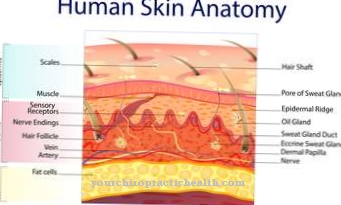Gilbert-Meulengracht's disease or Gilbert syndrome is a metabolic disorder that manifests itself as an increased bilirubin level in the blood. The disorder is genetic, but very rarely results in permanent damage.
What is Gilbert-Meulengracht's disease?

Meulengracht's disease is an effect that is characterized by an increased concentration of indirect bilirubin in the blood. This causes various symptoms such as yellowing of the eyes. Since indirect bilirubin is only sparingly soluble in water, it binds to albumins, which act as solubilizers.
Gilbert-Meulengracht's disease is a metabolic disorder. It is caused by delayed biochemical conversion processes in the blood and is completely harmless. However, there are various symptoms that can be treated.
causes
Meulengracht's disease is caused by a reduced activity of the enzyme UDP-glucuronosyltransferase. This enzyme is responsible for converting fat-soluble metabolic products into water-soluble end products.
If there is a disturbance in this process, various metabolic products and foreign substances such as drugs cannot be optimally prepared for elimination from the body. This causes the symptoms mentioned to occur. The red blood pigment heme is particularly disturbed.
The effect, which is triggered in particular by a reduced activity of the enzyme UDP-glucuronosyltransferase, only rarely has external causes. However, a low-fat diet can trigger the manageable symptoms. Fasting cures are also often associated with Gilbert-Meulengracht's disease.
Symptoms, ailments & signs
Gilbert-Meulengracht's disease is usually completely harmless. In the vast majority of cases, there are no symptoms at all. Only under certain conditions a yellow coloration of the white parts of the eyeball and in very rare cases also of the skin is observed. The yellow color is caused by an increased level of bilirubin in the blood, which is caused by the slowing down of the breakdown of bilirubin.
Because bilirubin increases during exercise, alcohol consumption, a low-fat diet or longer periods of fasting, the discoloration of the sclera and skin increases under these conditions. However, these are usually the only symptoms of Gilbert-Meulengracht's disease. Itching as in jaundice in the context of liver diseases does not occur here.
However, the yellow coloration can rarely be accompanied by uncharacteristic symptoms such as tiredness, abdominal pain with nausea, migraine-like headaches, loss of appetite and irritability. However, these symptoms are not dependent on the level of the bilirubin concentration. Another characteristic of Gilbert-Meulengracht's disease is that it usually only affects young men after puberty.
Gilbert-Meulengracht's disease has no disease value. There are no complications. The discoloration of the eyes and skin becomes less and less common in the course of life, until it often disappears completely with age. In rare cases, however, the accompanying symptoms have an adverse effect on the quality of life. The first appearance of yellowing of the eyes and skin can also have a worrying effect on those affected until they are informed about the harmlessness of the disease.
Diagnosis & course
Gilbert-Meulengracht's disease can be clearly diagnosed. To do this, it must be determined in a conversation with the person affected which symptoms are occurring. If it turns out that there is increased nausea in connection with yellow eyes, there may at least be a suspicion. Other symptoms may occur in connection with infections. The syndrome can be accompanied by symptoms in the liver, nausea and malaise. Symptoms are aggravated, especially during fasting or stress.
Beyond that, however, the effect has no symptoms worth mentioning and usually remains without any health complications for those affected. Therefore, it is difficult to determine Meulengracht's disease by external examination. A blood test, on the other hand, can quickly provide information about the syndrome. The bilirubin levels in particular are crucial. If only these values are increased and all other blood values are at a normal level, Gilber-Meulengracht's disease can be assumed.
While the syndrome is harmless, the diagnosis is critical. This way, serious diseases of the liver can be excluded. Hemolysis can also be ruled out with a clear diagnosis. In some cases, doctors therefore resort to a genetic test in order to be 100% certain.
The course of Gilbert syndrome is unproblematic. Symptoms such as yellow eyes and nausea usually go away after a few days. Even with longer fasts, the syndrome rarely leads to health restrictions. Often Meulengracht's disease is not noticed at all by those affected. However, one should not underestimate the symptoms. It could be a serious disease of the liver that must be treated in any case.
Complications
In most cases, Gilbert-Meulengracht's disease does not result in any particular restrictions or complications. Most patients live with the disease their entire lives and there is no reduction in life expectancy. Therefore, the disease does not need to be treated if there are no symptoms.
However, should complaints arise, these are usually expressed by tiredness and exhaustion on the part of the patient. Gilbert-Meulengracht's disease also significantly reduces the resilience of those affected, and everyday life can be impaired. Some people also suffer from nausea and yellow eyes. If the symptoms in the liver are severe, it can lead to severe discomfort.
Complications from Gilbert-Meulengracht's disease can occur if the person concerned is fasting, as the symptoms are exacerbated in this case. Usually Gilbert-Meulengracht's disease does not need treatment. Symptoms can only be reduced if the symptoms are severe. The life expectancy of the patient is not reduced by the disease and there are no further complications.
When should you go to the doctor?
Non-hemolytic jaundice, a metabolic disorder known as Gilbert-Meulengracht's disease, is already congenital. The symptoms that occur with this are noticed relatively quickly as they are associated with signs of jaundice. The first visit to the doctor therefore usually takes place early in life, often during puberty. Since there is no liver damage, an adapted diet is usually sufficient. The symptoms that the genetic defect can cause depend on several factors. Most of these can be influenced by the person concerned by making dietary adjustments. In this respect, when Gilbert-Meulengracht's disease is present, those affected have it in their own hands to remain almost symptom-free through an appropriate lifestyle.
It should be noted, however, that certain medications for other diseases or pain can worsen the symptoms of Gilbert-Meulengracht's disease.Therefore, when taking cholesterol-lowering preparations such as simvastatin or atorvastatin, a doctor should be consulted for monitoring purposes. The same is recommended for the use of estrogen-based contraceptives such as the birth control pill or widely used over-the-counter pain relievers such as paracetamol or ibuprofen.
If the eyes turn yellow, a doctor should always be visited. Jaundice or liver disorder must be excluded. The presence of Gilbert-Meulengracht's disease only requires abstaining from fasting cures and certain stimulants such as alcohol or nicotine. Therefore, visits to the doctor are usually not necessary.
Treatment & Therapy
Meulengracht's disease is a harmless metabolic disorder and therefore does not necessarily require treatment. However, there is an opportunity to correct the symptoms and provide education. This is especially necessary if those affected are unsettled by yellow eyes or repeated nausea and thus experience a reduced quality of life.
That is why the most important pillar of treatment is a detailed discussion with the person concerned. In this, the individual symptoms can be discussed and attributed to the high bilirubin values.
Another pillar of treatment is testing for incompatible drugs. Certain drugs in particular, such as paracetamol, can worsen the symptoms and should be discontinued under certain circumstances.
It can therefore be said that Meulengracht's disease does not normally cause any problems. At best, the uncertainty of those affected should be dispelled through education. In general, it is questionable whether Meulengracht's disease is a disease at all. Recent studies have shown that Gilber's syndrome can prevent colon cancer, arteriosclerosis and lung diseases.
You can find your medication here
➔ Medicines against nausea and vomitingOutlook & forecast
The prognosis for Gilbert-Meulengracht's disease is very good for patients. The life expectancy of those affected is just as high as that of those who are not affected. Gilbert-Meulengracht's disease is completely harmless in most of the cases that occur. Very rarely do the symptoms of the disease affect those affected. However, the older the person affected, the rarer and milder the symptoms of the disease appear. In a large number of cases, the symptoms disappear completely even in old age.
It is assumed that the mortality of those affected by the disease has not increased. There are even studies that indicate that the increased bilirubin level caused by the disease protects against certain lung diseases and thus reduces general mortality. Above all, this concerns protection against chronic obstructive pulmonary diseases and also against the dreaded lung cancer.
However, the cosmetic problem that can arise in those affected by yellowing of the eyes is often a very high burden. Often, outsiders cannot correctly interpret the color of the money and think of contagious diseases. In such cases, a doctor should be consulted to discuss possible treatment options. In general, however, therapy for Gilbert-Meulengracht's disease is not necessary.
prevention
Gilbert-Meulengracht's disease has no disease value and therefore does not need preventive treatment. If you want to avoid the characteristic yellowing of the eyes, it is advisable to avoid fasting and low-fat diets as far as possible.
The bilirubin values should thereby remain at a normal level. In addition, it is important to educate yourself about the syndrome. If other people suffer from the symptoms, Gilbert-Meulengracht's disease should be pointed out as the cause.
Medicines should only be taken after consulting a doctor. Despite the harmless symptoms, a comprehensive diagnosis should be made for yellow eyes. It is not uncommon for another disease to be involved.
You can do that yourself
As a rule, Gilbert-Meulengracht's disease is harmless. Treatment is neither possible nor necessary. However, it is advisable for those affected to find out more about the disease. A lot of information about dealing with the disease and avoiding symptoms can be found on the Internet in particular.
Gilbert-Meulengracht's disease only poses an indirect health risk if those affected take certain medications and these are more difficult to break down in the body. In a few cases this can lead to slight side effects. Symptoms of this kind are most common when taking cancer and HIV drugs. In order to clarify the tolerance, it is advisable to study the package insert before taking new medication. In general, those affected should try to spare the liver as much as possible. For this reason, you should avoid nicotine and alcohol as much as possible. It is also particularly important that those affected should not consume drugs.
In general, a healthy, balanced diet is advisable. To be on the safe side, we recommend that you only consume food supplements, foods with chemical additives, Ayurveda teas, Chinese herbs and herbal supplements in small doses. Those affected should generally avoid states of hunger. It is essential to discuss planned diets and excessive starvation diets with a doctor. In addition, those affected are advised to get enough sleep.

.jpg)




.jpg)






.jpg)

.jpg)
.jpg)











.jpg)